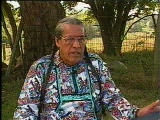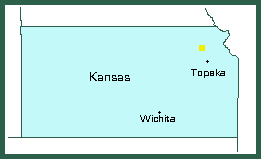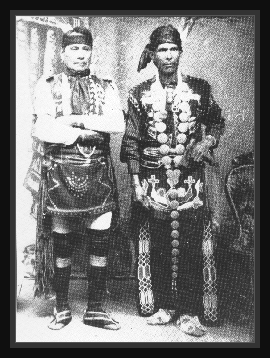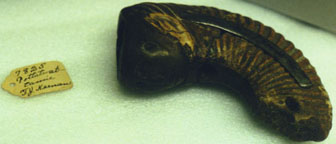|
bode'wadmimo speak Potawatomi
mzenegenek books nizhokmake'wen resources/help |
Home Page: news & updates
BWAKA - about us |

The Potawatomi are an American Indian nation from the
woodlands or Great Lakes area of North America. The exact meaning of the word
Potawatomi is not known, but most sources translate it as "People of the
Place of the Fire." Potawatomis call themselves in their own language,
nIshnabe'k ![]() ,
which simply means, the people.
,
which simply means, the people.
The Potawatomi Indians come from the woodlands of North
America. When the cmokmanek ![]() (whites) first encountered us in the seventeenth century, we
were living on the peninsula jutting out into Lake Michigan where Green Bay,
Wisconsin, is located today. Subsequently, we prospered and expanded into
present day Michigan, Indiana, Illinois and Ohio.
(whites) first encountered us in the seventeenth century, we
were living on the peninsula jutting out into Lake Michigan where Green Bay,
Wisconsin, is located today. Subsequently, we prospered and expanded into
present day Michigan, Indiana, Illinois and Ohio.

As the American nation expanded westward we were forced to leave our homes and disbursed in many directions. As a consequence, we are now organized into a number of different groups or bands, several of which are recognized as independent tribes by the U.S. government. We view ourselves as a single people in many important ways.
As a tribe, we have never abandoned our traditional language and customs. Even on the reservations, however, fluent speakers of our language are few and, for the most part, aging. We McKinneys belong to the Prairie Band, one of the most traditional Potawatomi nations.

The people of the Prairie Band Potawatomi Nation were among those removed to west of the Mississippi in the 19th century by the federal government. Our reservation is near Mayetta, Kansas.
Here is a list of the Potawatomi bands, with
links to their official websites, for the bands that maintain them. Addresses
of the tribal offices can be found on the sources
page in our genealogy section.
The Potawatomi bands come together in the fall of each year for a Traditional Gathering. The 1995 Gathering took place in Kansas; 1996 saw us in Hannahville, MI; Shawnee was the Gathering place in 1997; the sixth annual Gathering was hosted by the Nottawaseppi Huron Band at their reservation in Athens, Michigan in August, 1998.
Most of our people live away from the reservation. Through this website we hope to give these people -- of whom I am one -- an opportunity to increase their knowledge of our language and culture and enjoy what we hope will be an expanding collection of materials that celebrate the richness of our heritage.
In our nIshnabe'k section, we share aspects of oulture and history of interest to all Potawatomi people, but especially to the Prairie Band, since that is our heritage. We touch on a wide range of subjects:
We are not attempting to cover any of these topics completely or in detail. Our hope is to build a collection of texts, graphics and references that we find worthwhile. Perhaps you will find them interesting, too.

Two of our hypertexts tell a great deal about the history and culture of the Potawatomi People and particularly about the Prairie Band.
The first is
Gary Mitchell's
![]() "Stories of the Potawatomi
People".
"Stories of the Potawatomi
People".
Gary is the Prairie Band historian and has studied the history of the
Potawatomi for many years. His book covers our history from the beginning to
today, and from the Potawatomi point of view. It contains many photographs, old
and new, of our people.
The second is an essay by
William Elsey Connelley,
"The Prairie Band of Pottawatomie Indians"  , published in 1918. Connelley was historian of the Kansas
State Historical Society and an enthusiastic advocate of the Native
American cause. A number of 1917 photographs of Prairie Band people
were incorporated into the essay and are reproduced here.
, published in 1918. Connelley was historian of the Kansas
State Historical Society and an enthusiastic advocate of the Native
American cause. A number of 1917 photographs of Prairie Band people
were incorporated into the essay and are reproduced here.
The Treaties Between the Potawatomi and the United States of America, 1789 - 1867. All of the treaties between the Potawatomi and the USA are here. Graphics are taken from the pictographs by Mogawh and Noname found on the signature pages of the treaties of July 4, 1805 and November 17, 1807. Our sources are George E. Fay's Treaties Between the Potawatomi Tribe of Indians and the United States of America, 1789 - 1867, Charles J. Kappler's Indian Treaties 1778-1883 and, in some cases, the treaties themselves as found on microfilm in the files of the National Archives. Tom Ford, one of our volunteers, did the research for this project.
Menominee's Letters. The treaty of August 5, 1836 ceded to the United States the reserve granted to Menominee, No-taw-kah, Muck-kah-tah-mo-way and Pee-pin-oh-waw and their bands by the treaty of October 26, 1832. The 1836 treaty does not carry Menominee's name. Menominee, Muck-kah-tah-mo-way, Pee-pin-oh-waw and the sons of No-taw-kah wrote at least three letters protesting that none of them had attended the council or signed the treaty and that the treaty was invalid. These protest letters are presented here thanks to Tom Ford who obtained copies from the National Archives.
Our next series of hypertexts deal with the Trail of Death, the forced march of more than eight hundred tribal members from their homes in Indiana to the reservation in Kansas in the fall of 1838.
Here is a map of the Trail of Death, and a list of markers that have been raised along the route.
In a series of letters, John Tipton, who led the first part of the Trail of Death, related the early stages of the forced removal in which the Potawatomi were rounded up, Father Pettit was permitted to accompany the group, and the journey was begun.
Some of Tipton's men were ordered to do a brief survey of the lands cultivated by the Potawatomi in and around Menominee's village in Marshall County, Indiana. Here is their report.
Here are extensive excerpts from Trail of Death 1838 Diary, condensed and edited by Shirley Willard and Judy Cecrle, a 1988 publication of the Fulton County Historical Society commemorating the 150th anniversary of the Trail of Death, together with materials collected by Ivan Nunemaker. You will find an abbreviated diary of the removal, a reference list of further materials, a roll of the Potawatomi forcibly escorted to Kansas and a list of the Trail encampments.
Susan Campbell and Shirley Willard have written and published a new book. Titled Potawatomi Trail of Death: Indiana to Kansas - 1838, it is a compilation of original documents from the time of the Removal (including the complete journal of Father Benjamin Marie Petit), drawings by George Winter, who documented the Removal both in picture and word, newly-transcribed lists of those who were removed (taken from original microfilm), a new map, and articles written by descendants of those who have been participating in the Trail of Death caravans by dedicating new markers along the way. Locations for all 74 markers are also included. Thoroughly indexed, the book is 428 pages in length and can be ordered through the Fulton County Historical Society, 37E 375N, Rochester, IN 46975. The book is priced at $40 plus $6 shipping and handling. All profits go to the historical society for the creation of maps and the maintenance of markers.
Here are some additional historical materials:
A brief history of the Prairie Band: Gary Mitchell's Brief Chronology of Events for the Prairie Band Potawatomi

Potawatomi pipe bowl, Smithsonian collection, acquired 1869.
A traditional Potawatomi blouse belonging to Peggy Kinder was photographed at the Powwow in Shawnee last summer by Eric and Susan Campbell. Peggy told us about the blouse, and about the ribbon work on her skirt. Our thanks to Peggy, Eric and Susan.
Long Elk at Little Bighorn by Jack Wooldridge is a beautiful painting by a contemporary Citizen Potawatomi Nation artist and writer, and a good friend. We are honored that he has offered it to us for exhibit here.
![]() Poems by Susan Campbell, including "Cage NokmIsen," which tells the story of the Trail of Death, and two recent works.
Poems by Susan Campbell, including "Cage NokmIsen," which tells the story of the Trail of Death, and two recent works.
Potawatomi beadwork and ribbon applique at the
Denver Museum of Natural History
Susan obtained permission for us to display these photos of a few
of the museum's Potawatomi holdings.
Potawatomi beadwork Some lovely Potawatomi beadwork on display at the Citizen Potawatomi Nation Museum in Shawnee, Oklahoma, belongs to Susan Campbell's family. Susan has given us permission to use photographs of the pieces and designs from them on the website.
We expect to add links to Potawatomi writing and art and crafts in the future. We hope to reproduce a collection of photographs of Potawatomi arts and crafts over time. If you have any ideas about where we can locate material or who we might contact in this regard, please let us know.

Our genealogy section was added in November, 1997. Susan Campbell of the Citizen Nation Potawatomi has volunteered to develop these pages. She tells how to begin a genealogy study, and has developed a list of links and resources especially relevant to the Potawatomi researcher. We provide some important historical member lists of several bands and look forward to building a collection of family trees and stories.
Many Potawatomi have embraced the opportunities for education and communication that technology makes available. Prairie Band has an official website. It has information on our tribe and reservation; on the tribal council and tribal programs, including phone numbers; on the history of the tribe and some of our stories; and about the casino on the reservation. It contains an online copy of our official brochure that is given to visitors to the reservation. All of the official websites that Potawatomi bands maintain are listed above.
We recommend
Gary
Mitchell's
![]() "Stories of the Potawatomi
People" for insights into the life and concerns of the Potawatomi
and particularly the Prairie Band today.
"Stories of the Potawatomi
People" for insights into the life and concerns of the Potawatomi
and particularly the Prairie Band today.
Click the map above to see a detail map of the contemporary reservation. Please note: the map is large in size. The file is 412 KB - nearly half a million bytes - and may take a while to download into your computer.
| We remember our grandfathers in many ways. One of them is the Trail of Death Commemorative Caravan, first held in 1988, 150 years after the original Trail of Death. Five years later, a second Caravan traveled the route of the original forced removal. In September, a third Commemorative Caravan followed the route, now officially designated the Trail of Death Regional Historic Trail, once more. |
![]() Keeping our culture alive and passing it on to our
children is
a vital concern for many of us who live off the reservation as well as for those
who live on it. Jack Wooldridge, a member of the Citizen Nation and, to
our delight, a member of our BWAKA group, is a writer and artist whose
children's stories introduce young readers to Potawatomi words and values. You
will enjoy a visit to his charming website
.
Keeping our culture alive and passing it on to our
children is
a vital concern for many of us who live off the reservation as well as for those
who live on it. Jack Wooldridge, a member of the Citizen Nation and, to
our delight, a member of our BWAKA group, is a writer and artist whose
children's stories introduce young readers to Potawatomi words and values. You
will enjoy a visit to his charming website
.
![]() Pictures of nake'ndumwajek ("wise ones";
speakers) that were videotaped in 1995.
Pictures of nake'ndumwajek ("wise ones";
speakers) that were videotaped in 1995.
![]() Pictures from the Seven Bands Traditional Gathering,
Prairie Band Reservation, Mayetta, KS, 1995
Pictures from the Seven Bands Traditional Gathering,
Prairie Band Reservation, Mayetta, KS, 1995
![]() Pictures from the Seven Bands Traditional Gathering,
Hannahville Reservation, Hannahville, MI, 1996
Pictures from the Seven Bands Traditional Gathering,
Hannahville Reservation, Hannahville, MI, 1996
![]() Pictures from the Seven Bands Traditional Gathering,
Citizen Nation Reservation, Shawnee, OK, 1997
Pictures from the Seven Bands Traditional Gathering,
Citizen Nation Reservation, Shawnee, OK, 1997